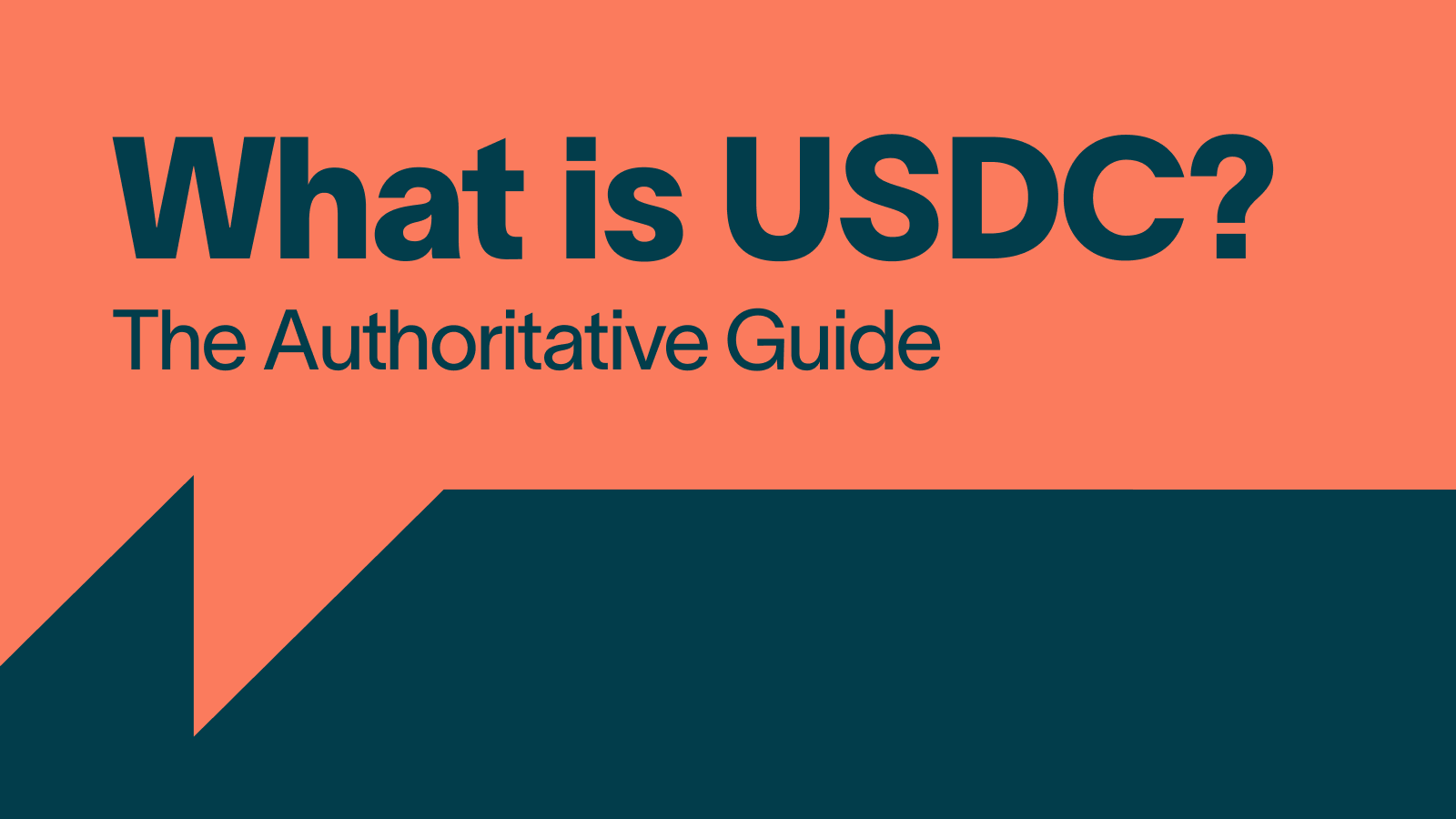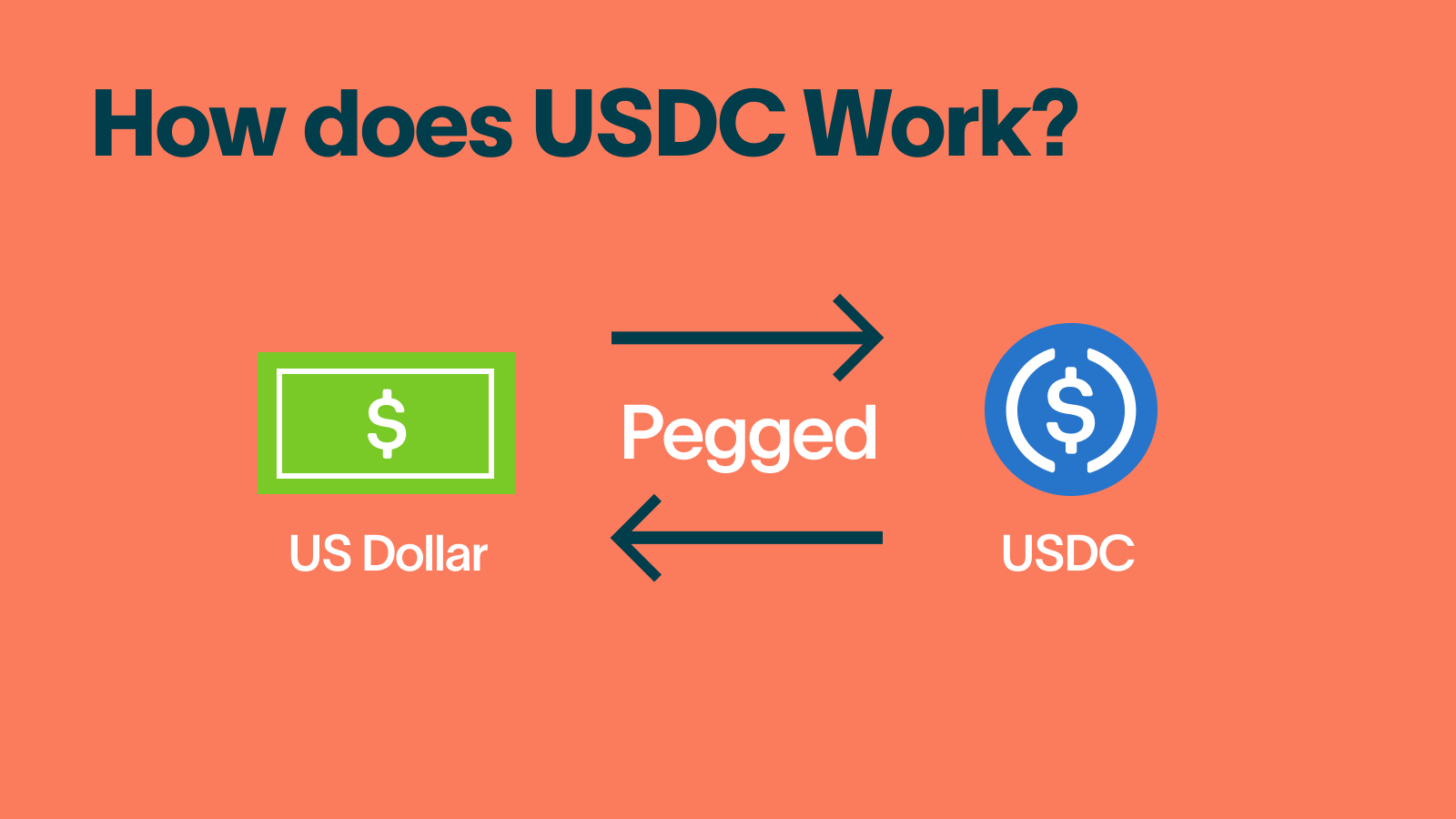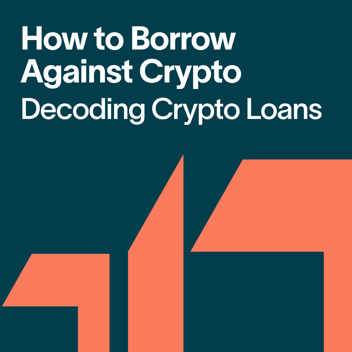What is USDC? The Authoritative Guide

If you have spent any amount of time in the crypto space, then you will likely come across USDC. While this cryptocurrency is not as well-known as giants such as Bitcoin and Ethereum, it is arguably just as important to the industry. But what is USDC, who runs it, and why is it so significant in crypto?
What Is USD Coin (USDC)?
USD Coin, or USDC, is a special type of cryptocurrency known as a stablecoin. It is “pegged” to the US dollar. This means that one USDC is designed to be equal to one dollar. It is a digital asset that is essentially locked in price, meaning there are no intense fluctuations or price changes, as you would expect from other cryptocurrencies. You can find USDC on just about any crypto exchange, along with a wide range of lending platforms including Ledn.
How does USDC work?
Stablecoins like USDC are digital assets that are built to have a value that mimics the value of something else; typically a fiat coin (or legal tender). In the case of USDC, it is designed to mimic the price of the US dollar. In the crypto sphere, this is referred to as a coin being pegged.

Stablecoins like USDC offer a safe haven for crypto users, allowing them to own a digital asset that does not experience the sharp rises and falls that assets typically undergo, such as Bitcoin or Ethereum. In this sense, USDC is highly predictable in its value. It works very differently from other digital assets, in that you typically do not invest in something like USDC (due to its stagnant price), but the process of sending, storing, and spending it is identical to other assets. There is no learning curve involved in using it.
Why does USDC have value?
To understand USDC, we need to answer the question “what is USDC backed by?” In other words, what is the underlying value that keeps USDC pegged to one dollar? The answer is that Circle, the company that issues and releases USDC, has a reserve of assets that have an equal value to the number of USDC that is distributed.
This means that there is a 1:1 ratio between USDC in circulation and the value of reserve assets held by Circle. This reserve is made up of actual US dollars, as well as US treasuries. These treasuries are known as debt securities; basically, they are loans made by investors to the U.S. government in exchange for a promise to be repaid with interest at a later date. They are considered extremely safe and very low risk, and so they work as a great way of adding to Circle’s 1:1 reserve.
In summary, USDC is able to maintain its value of being equal to one dollar because Circle ensures that every USDC in circulation is matched with the value of one dollar, held in reserve.
Why buy USDC?
People buy USDC because it allows them to own a digital asset that is valued the same as the US dollar, whilst also having the benefits of being a cryptocurrency. This means that it is basically like using fiat for blockchain transactions, which is something that is not possible without the help of a stablecoin. Not only that, but its predictability and lack of fluctuation mean that people can comfortably own USDC without worrying about its value changing. This is great for crypto users (and especially traders) who are looking for an easier form of liquidity than US dollars. The fact that they are blockchain-based makes them more accessible in the crypto space, and also means that trades can be made and settled with them quicker than they can with fiat; without the requirement to convert or withdraw into legal tender.
USDC has also found significant adoption in emerging markets and countries with rapidly developing economies. This is because it allows people in these countries to access an asset with equal value to the dollar in a simple and straightforward way. The fact that USDC is a cryptocurrency makes it more accessible globally because there are no financial barriers to cross. Blockchain tech is available worldwide, and therefore, so is USDC. People can even use it on their smartphones with ease.
The upshot of this is that people in emerging markets can rely on USDC in a way that they might not be able to with their native currencies. When a country is rapidly developing and growing on an economic level, there tends to be increased inflation for that country’s own currency. By having access to stablecoins like USDC, residents of these countries can use it without being concerned about their nation’s own inflationary experience.
The same cannot be achieved so easily with actual US dollars, as they can be hard to get hold of in developing countries, or in countries that have political conflicts with the US. Situations like this make USDC the ideal option.
It is worth also highlighting that USDC is favored by many people in the world who are unbanked or underbanked, meaning they do not have bank accounts or access to the full suite of traditional financial tools that middle-class Westerners often take for granted. This is because it allows these individuals to use a cryptocurrency that represents the price of USD without having to jump through any traditional financial hoops, such as having a permanent residency, a working bank account, or identifying documentation like a passport or ID. For many, attaining these things is extremely hard due to life circumstances or unstable governments, and so stablecoins like USDC act as a fantastic alternative to fiat.
For example, users who do not have some of these requirements can struggle trying to escape poverty, because certain financial instruments, such as savings accounts, are unattainable. If they were to request one from a bank or traditional lender, they would be turned down immediately as identifying information and permanent residencies are often seen as basic requirements. This creates a harmful scenario where the tools to alleviate poverty can only be accessed if somebody is already in a stable financial and societal position. Essentially, it's the paradox of needing money to make money, or in this case, needing stability to attain stability.
Stablecoins, like USDC, provide a beacon of hope in such scenarios. They democratize access to essential financial tools. With just a smartphone and internet connection, users can access a global financial system, enabling them to save, transact, and invest in ways that were previously unimaginable. For those living in regions with hyperinflation, where the local currency rapidly loses value, pegging their savings to a stable currency like the USD can mean the difference between preserving their wealth or watching it erode.
What are the advantages and disadvantages of USD Coin?
Let’s take a look at what the pros and cons are of using USDC!
Advantages of USD Coin
USDC has a stable value during times of volatility. Unlike most other cryptocurrencies, stablecoins like USDC stay pegged to one consistent value. This is great for people who want to own crypto, but are worried about price fluctuations. Sometimes, people prefer to keep their money like this (rather than cash it out into fiat) because it means they can easily trade it with other cryptocurrencies without having to undergo the long rigmarole of using an intermediary to swap their fiat and give them digital assets in return. Day traders especially enjoy having stablecoins for this reason.
USDC is fully backed by reserve assets. The fact that Circle, the company behind USDC, ensures that the stablecoin has a 1:1 ratio of reserves means that users can be assured that it is accurately priced and unlikely to drop significantly in value. Circle even publishes its monthly reserve attestations and reports, meaning that people can verify for themselves that they are legitimate and trustworthy. This creates a powerful sense of security.
USDC is Highly Transparent. Connecting this to the previous point, USDC is well-known for its open reporting policy, where it publishes consistent reports on its ratio of reserves, and how it earns its money. This is in stark contrast to its main competitor, USDT (or Tether). This, too, is a stablecoin, however it does not hold itself to the same standard, when it comes to transparency. Despite USDT being the market leader when it comes to stablecoins, it is much less transparent than USDC.
Related Content: What is USDT? The Expert Guide
Earn up to 10.0% APY on USDC. Ledn’s Growth Accounts allow users to earn interest on their USDC. This ranges up to a staggering 10.0% APY, which is perfect for those who own USDC and are looking for a passive income. This is a highly competitive rate. Much like Circle, Ledn also publishes reports on their reserves, known as our Proof of Reserves. They are highly transparent, and welcome its user base to look through their reports to help build trust.
USDC runs on multiple blockchains. USDC functions on a wide range of blockchains. It runs on Ethereum, TRON, and Solana, and Circle has announced plans for it to operate on Polkadot as well in the near-future.
Available to all, regardless of your financial situation. USDC can be used by anybody around the globe, regardless of whether you have a bank account or not. This is great for people who struggle to obtain support from traditional financial organizations, or people who belong to developing nations and even wartorn countries who have unstable governments and financial systems in place.
Disadvantages of USD Coin
A centralized asset. While USDC is a blockchain-based cryptocurrency that is available to all, it is managed and maintained by a highly centralized company. In one sense, this is good as it means that there are humans at the helm who are ensuring that its reserves always reach a 1:1 ratio. However, many crypto enthusiasts are weary of centralization as it goes against the original philosophy of cryptocurrencies, which was to create a decentralized financial system, free from the control of any single entity or government. For people who feel strongly about this, they may prefer to work with a decentralized cryptocurrency, such as DAI.
Reduced Circulating Supply Compared to USDT. While USDC has a decent amount of coins in circulation, its numbers pail in comparison to USDT/Tether, the stablecoin market leader. USDT has around 66% of the market share, whereas USDC only has around 20%. This is definitely something that USDC is actively working on, and so these numbers are by no means static. But for the time being, this does make USDC slightly more scarce than its main competitor.
Regulatory Risks. Circle appears to be very conscious of regulators, and works hard to create a stablecoin that is compliant with them. However, in this turbulent age where governments are still forming clear rules and laws about the crypto industry, there is a lot of questioning about what is allowed and permissible. With this in mind, a situation could arise where regulators scrutinize Circle and USDC in the future. While they appear to be operating above board and legitimately, the US SEC has been known to question the actions and behaviors of many companies in the crypto space. If something like this was to happen, it could slow the progress of USDC and potentially cause issues regarding its reserve or the frequency of new tokens being issued. That being said, its dedication to transparency and openness makes it automatically less risky than USDT, which is a stablecoin that crypto users have been skeptical about for many years.
Related Content: Why Did USDC Depeg? Is it Safe Now?
Redemption and Blacklisting Risks. Due to USDC’s highly centralized nature, it would be possible for Circle to prevent somebody from exchanging USDC for its equivalent value in USD. The company could blacklist certain crypto addresses from doing this, citing legal reasons or suspicions of foul-play on the user-side. Generally, people do not redeem USDC via Circle’s own website and network, and instead do this via a third party such as an exchange or a lending company, so this might not be a major risk. But the fact that it is possible for Circle to disallow any redemption channel is worrisome and problematic, as it shows the potential power that centralized companies have.
Who Runs USD Coin?
USDC is run by Circle, a US-based cryptocurrency company that launched in 2013. Since its creation, Circle has been of particular interest to traditional financial organizations, and even received significant funding from Goldman Sachs in its early years. Since then, it has also secured funding from giants such as BlackRock and Fidelity Investments. In the past, Coinbase also had intimate involvement in the building and maintaining of USDC. However, in recent times this has stopped.
What is USDC Backed By?
USDC is backed by both US dollars and US treasuries, which are short-term debt securities issued by the US government. All of its backing makes up a 1:1 ratio of reserves for every USDC in circulation.
The History of USDC
USDC was created by Circle, a company founded by Jeremy Allaire and Sean Neville. Both of which are entrepreneurs who have experience in the FinTech world. The primary product Circle creates is USDC, which was launched in 2018. The aim was to build a digital asset that could be used globally, whilst also maintaining a rigid and pegged price, making it perfect for remittance and other financial actions. Since then, it has grown to become one of the most used stablecoins in the industry. Back then if you were to ask “what network is USDC on?” the only answer would be Ethereum. However, since then, it has expanded to various other blockchain ecosystems. As of August 2023, there is $28 billion worth of USDC in circulation with a total of $12.02 trillion worth of on-chain transactions recorded.
The Future of USDC
USDC is currently one of the most accepted and well-regarded stablecoins on the market. It has built a solid reputation, and is supported by many businesses and corporations worldwide. The future looks very bright for this project. In its immediate roadmap, there are plans for USDC to become accessible on a wider range of blockchains, including Polkadot, NEAR, and Polygon. This is a huge sign of progress, as it shows that Circle is committed to creating an interoperable asset, meaning that it functions on a range of blockchains.
Circle is also in the process of working more directly with Coinbase, a company which they used to be closely affiliated with in the early years of USDC, but eventually drifted apart. With their new plans, Coinbase will be taking an equity stake in the company. The idea is that both organizations can benefit from a stronger symbiotic relationship, which could help strengthen the stablecoin even further than it already is.
How Do You Maximise Your Returns With USDC?
If you want to use USDC as a means of building greater returns for yourself, then you can open a USDC Growth Account and begin generating interest with the help of Ledn. Ledn Growth Accounts are a fantastic option to try out– users can earn up to 9.00% APY on their USDC. Assets held in these accounts are only exposed to the counterparties that generate yield for the end user, adding an important layer of protection and trust. Not only this, but Ledn Growth Account users are able to swiftly transfer their assets between this account and a separate Ledn Transaction account that allows for easy asset addition to and withdrawal from the Ledn platform.
Related Content: How to Earn Interest on Stablecoins
Conclusion
USDC is a deeply important part of the crypto world. Acting as a trustworthy and widely available stablecoin, USDC is able to help people save, generate interest, store wealth, and use a US dollar-pegged asset with ease. It has been a major force in providing stability to the market via its 1:1 reserve ratio, and has built a strong reputation because of it.
Coupled with Ledn, USDC becomes an extremely powerful method of earning a passive income via interest. Ledn Growth Accounts help give users a means of generating interest in a simple and effective way. Plus, much like USDC, Ledn is transparent about their activity, via their Proof of Reserves, which you can check out here.
Sponsored by 21 Technologies Inc. and its affiliates (“Ledn”). All reviews and opinions expressed are based on my personal views.



